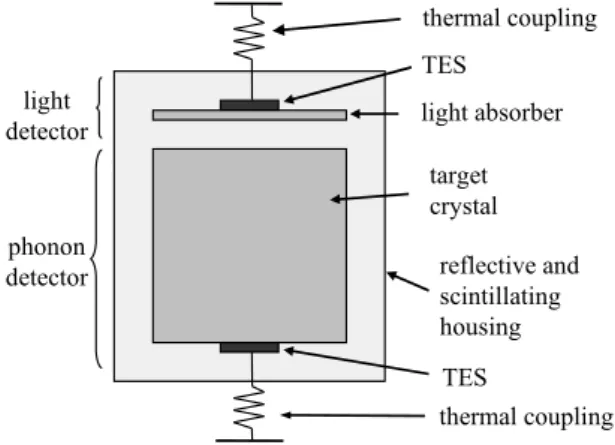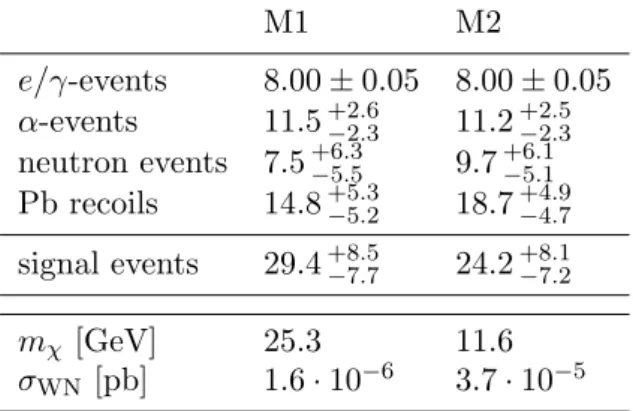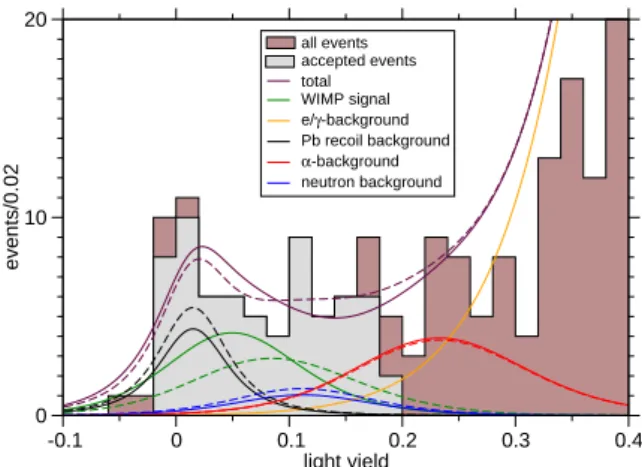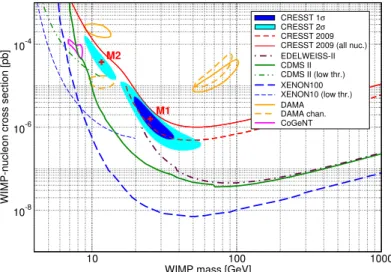Latest results from the CRESST-II Dark Matter Search
F Petricca
1, G Angloher
1, M Bauer
3, I Bavykina
1, A Bento
1,5, C Bucci
4, C Ciemniak
2, G Deuter
3, F v Feilitzsch
2, D Hauff
1, P Huff
1, C Isaila
2, J Jochum
3, M Kiefer
1, M Kimmerle
3, J C Lanfranchi
2, S Pfister
2, W Potzel
2, F Pr¨ obst
1, F Reindl
1, S Roth
2, K Rottler
3, C Sailer
3, K Sch¨ affner
1, J Schmaler
1, S Scholl
3, W Seidel
1, M v Sivers
2, L Stodolsky
1, C Strandhagen
3, R Strauss
2, A Tanzke
1, I Usherov
3, S Wawoczny
2, M Willers
2and A Z¨ oller
21
Max-Planck-Institut f¨ ur Physik, F¨ ohringer Ring 6, D-80805 M¨ unchen, Germany
2
Physik-Department E15, Technische Universit¨ at M¨ unchen, D-85747 Garching, Germany
3
Eberhard-Karls-Universit¨ at T¨ ubingen, D-72076 T¨ ubingen, Germany
4
INFN, Laboratori Nazionali del Gran Sasso, I-67010 Assergi, Italy
5
CI, Physics Department, University of Coimbra, P-3004 516 Coimbra, Portugal E-mail: petricca@mpp.mpg.de
Abstract. The CRESST-II experiment is searching for Dark Matter particles in the form of WIMPs via their elastic scattering off nuclei in a target material. The CRESST target consists of scintillating CaWO
4crystals which are operated as cryogenic calorimeters at millikelvin temperatures and read out by transition edge sensors. Each interaction in CaWO
4produces a phonon signal in the target crystal and also a light signal that is measured by a secondary cryogenic calorimeter, allowing a very efficient discrimination between electron recoils from radioactive e/γ background and nuclear recoils. Moreover, to some extent, the different types of recoiling nuclei (O, Ca, W) can be distinguished.
In the paper we present the latest results of the experiment, obtained from a net exposure of 730kg days acquired with 8 detectors between July 2009 and March 2011. The data has shown a considerable number of events in our signal region. Since this large number of events is not consistent with the known sources of background in our experiment, we discuss the compatibility of this excess of events with a possible WIMP-signal.
1. Introduction
The CRESST-II (Cryogenic Rare Event Search with Superconducting Thermometers) experiment, located at the Laboratori Nazionali del Gran Sasso in Italy, aims for direct detection of WIMP Dark Matter via their elastic scattering off nuclei in a target material. The main challenges of this kind of measurement are to achieve a sufficient background suppression to be sensitive to the extremely low expected rates and to detect the small recoil energies anticipated in WIMP-nucleus scatterings (see Figure 1).
To fulfil these requirements, CRESST uses scintillating CaWO
4crystals operated as cryogenic
detectors in a low-background environment. The scintillation produced at the target material
allows for a discrimination of the type of interacting particle on an event-by-event basis. This
enables us to distinguish between potential rare WIMP interactions producing nuclear recoils and events induced by the dominant radioactive backgrounds which are mainly constituted of e/γ-events.
In the following we report on the latest data collected with the CRESST setup between 2009 and 2011, corresponding to a total net exposure of 730 kg d.
2. CRESST detectors 2.1. Detector modules
The CRESST target for WIMP interactions consists of scintillating CaWO
4crystals cut in a cylindrical shape with 40 mm in diameter and height. The present experimental setup is capable to accommodate up to 33 of these crystals for a maximum target mass of about 10 kg.
For coherently scattering WIMPs, the total scattering rate in CaWO
4is dominated by the heavy tungsten nuclei (σ ∝ A
2, with A being the mass number of the target nucleus). However, given the limitation imposed by the finite energy threshold of the detectors, scatterings off other constituents may become relevant considering the kinematics involved. To illustrate this point Figure 2 shows, for different WIMP masses, the contributions of the three elements in CaWO
4in the energy interval between 12 and 40 keV which is a typical energy range of interest for the CRESST detectors. Tungsten completely dominates only for WIMPs with masses above
[keV]
ER
0 10 20 30 40 50 60
[ 1 / (keV kg d pb) ] RdR/dE
103
104
105
10 GeV/c2
100 GeV/c2
1000 GeV/c2
Figure 1. Differential event rates for various WIMP masses in CaWO
4detectors versus the nuclear recoil energy E
R. The rates are given per keV, kg and day for a WIMP-nucleon cross-section of 1 pb.
WIMP mass [GeV]
10 102 103
counts per kg d pb in [12,40] keV
10-1
1 10 102
103
104
105 W
Ca
O
Figure 2. Contributions of the three types of nuclei present in a CaWO
4target to the total rate of WIMP interactions, as a function of the WIMP mass and for a cross-section of 1 pb, assuming coherent WIMP scatterings and a detector with a sensitive energy range between 12 and 40 keV.
30 GeV. For low WIMP masses, up to about 12 GeV, however the scatterings off tungsten are completely below threshold, and oxygen and calcium recoils give the only possible Dark Matter signal. For this reason, in order to be sensitive to the largest possible range of WIMP masses, when looking for possible WIMP interactions, we consider recoils of all three types of nuclei in CaWO
4.
The target crystals are operated as cryogenic calorimeters, read out with tungsten transition edge sensors (TES)[1], at temperatures of about 10 mK. The CaWO
4crystals with their TESs are indicated as phonon detectors. The extreme sensitivity of these detectors makes them suitable to measure the low-energy nuclear recoils expected in WIMP-nucleus scatterings.
In order to measure the small fraction of the energy deposited in the target crystal which is
converted into scintillation light, each crystal is paired with a separate cryogenic light detector.
Each light detector consists of a light absorber (sapphire wafer of 40 mm diameter and 0.4 mm thickness, with an epitaxially grown silicon layer on one side for photon absorption or pure silicon wafer with the same geometry) equipped, similar to the target crystal, with a tungsten TES.
A crystal and the corresponding light detector form a detector module. A schematic view of a
TES
target crystal
TES reflective and scintillating housing light
detector
phonon detector
light absorber thermal coupling
thermal coupling
Figure 3. Schematic drawing of a CRESST detector module, con- sisting of the target crystal and an independent light detector. Both are read out by transition edge sen- sors (TES) and are enclosed in a common reflective and scintillating housing.
module is shown in Figure 3. Both detectors of a module are held by thin, silver-coated bronze clamps and are enclosed in a common scintillating and highly reflective housing to maximize the collection of the scintillation light [2].
2.2. Event discrimination
Following a particle interaction, a detector module yields two coincident signals (one from the phonon and one from the light detector). While the phonon channel provides a sensitive measurement of the total energy deposition in the target (approximately independent of the type of interacting particle), the light signal is very sensitive to the different types of interactions and can therefore be used for discrimination. We define the light yield (LY) of an event as the ratio of energy measured with the light detector divided by the energy measured with the phonon detector. The energy scale of the light channel is defined such that 122 keV γ ’s from a
57Co calibration source have a light yield of unity. α’s and nuclear recoils are observed to have a lower light yield [2]. As a consequence, interactions from particles of different nature lead to characteristic bands in the light yield-energy plane, allowing for a very efficient discrimination between the potential signals, expected to show up as nuclear recoils, and the dominant radioactive background which is mainly constituted of e/γ events. Furthermore, since the light yield of nuclear recoils varies widely among different nuclei, to the extent that the different recoil bands can be separated in the light yield-energy plane it is possible to identify the type of recoiling nucleus. This distinctive feature of CRESST allows to study possible WIMP interactions with different target nuclei in parallel in the same setup.
3. The latest CRESST run
The latest run of CRESST took place between June 2009 and April 2011. It included a neutron test and γ-calibrations with
57Co and
232Th sources. Out of the 18 detector modules installed in the cryostat only 8 were used for the Dark Matter analysis. One was excluded due to its unusually poor energy resolution and an additional one was excluded being equipped with a test ZnWO
4crystal. The remaining ones mainly had difficulties in cooling the light detectors and could therefore not provide the full information needed for Dark Matter analysis, but still were used to tag coincident events with signals in more than one detector module.
The validity of events which are considered for analysis is ensured with few basic quality cuts
applied to the raw data [2]. The data set discussed here was collected by eight detector
modules, between July 2009 and March 2011, corresponding to a total net exposure after cuts of 730 kg days.
3.1. Acceptance region
As any of the nuclei in CaWO
4can be the relevant target for WIMP scattering depending on the mass of a possible WIMP, the acceptance region is chosen such that it extends between the upper boundary of the oxygen band and the lower boundary of the tungsten band and that implicitly includes the calcium band. Since, as a result of the incoming WIMP velocities and nuclear form factors, no significant WIMP signal is expected at energies above 40 keV (see Figure 1), the accepted recoil energies are limited by this value. The lower energy bound, in each detector module, is chosen such that the expected e/γ-leakage into the acceptance region is one event in the whole data set of that module. Due to the different resolutions (width of the bands) and levels of e/γ-background in the crystals, this value is different for each module.
A typical acceptance region is shown in orange in Figure 4 which presents in the light yield- energy plane the data set collected with one detector module (Ch51). The calculated bands for α’s, oxygen recoils, and tungsten recoils shown in the figure are determined as described in [2].
With this definition of the acceptance region we find 67 accepted events in the sum over the eight detector modules used for Dark Matter analysis.
0 20 40 60 80 100 120 140
Energy [keV]
0 0.5 1
Light Yield
W α O e/γ
Figure 4. The data of one detector module (Ch51), shown in the light yield vs. recoil energy plane. The large population around a light yield of 1 is due to e/γ-background events. The shaded areas indicate the bands, where alpha (yellow), oxygen (turquoise), and tungsten (grey) recoil events are expected. Additionally highlighted is the acceptance region of this detector (orange) and the reference regions in the α-band (magenta) and in the
206Pb-recoils band (green).
4. Background in the acceptance region
In Figure 4, next to the dominant e/γ-background, which is observed around a light yield of 1, we identify other background sources which could contribute events into the acceptance region.
The scope of the analysis is to estimate the contribution of each of the identified backgrounds and
to investigate a possible excess above the expectation. This is done using a maximum likelihood
analysis which is thoroughly discussed in [2]. Here only its final results will be presented together
with a qualitative discussion of the backgrounds in order to clarify the basic arguments and
assumptions used in the analysis.
4.1. α-Background
In the data (see Figure 4 as an example) we observe low-energy α’s with energies down to few keV. We understand these events to be due to α particles which have lost most of their energy before reaching the target crystals (for details on the housing of the detector modules see [2]).
The presence of these events in our data is a consequence of the contamination with α emitters of the non-scintillating clamps holding the crystals. These events are present in all detectors, though the rates vary among modules.
Since the acceptance region has some overlap with the α-band, low energy α-events may be misidentified, leading to a certain number of background events in the acceptance region. In order to estimate this background contribution we select a reference region of the alpha band (highlighted in magenta in Figure 4) which is free of overlap with any other band. For this reference region we use an energy range of 100 keV whose low-energy bound is chosen in each detector module such that the expected e/γ-leakage is 0.1 event in the whole reference region of that module [2]. For each module we estimate in the reference region the energy spectrum dN
α/dE of the low-energy α-events. Using this spectrum we calculate for each individual module the ratio of α-events expected in the reference region and of α-events expected in the acceptance region. This ratio is then used to estimate the expected α-events in the whole acceptance region from the number of events observed in the reference region.
4.2. Lead Recoil Background
In Figure 4 we also identify an event population in and below the tungsten band around 100 keV.
This population is caused by the lead nuclei from the α-decays of
210Po present on the surface of the holding clamps and is present, though with different intensities, in all detector modules.
The event distribution of the
206Pb recoils peaks at the full recoil energy of 103 keV but it exhibits a decreasing low-energy tail which, in some detectors, reaches the energy range of interest for Dark Matter. Since this lead-recoil band and the acceptance region overlap considerably, a leakage of some
206Pb events into the acceptance region cannot be excluded.
For an estimate of this background, we follow a similar strategy as for the α background. We define a reference region for each detector module which contains predominantly
206Pb recoils.
As a reference region, we choose the low-energy tail of the distribution (≤90 keV) at energies above the acceptance region (≥40 keV), where a possible WIMP signal cannot contribute. An example is highlighted in green in Figure 4. In this region we model the spectral energy density dN
Pb/dE of the
206Pb events and then extrapolate the fit function into the energy range of the acceptance region to estimate the number of
206Pb events expected there [2].
4.3. Neutron Background
Neutron scatterings, which mainly induce oxygen recoils in the energy range of interest, could -if neutrons are present- also contribute to events observed in the acceptance region. Differently from WIMPs, neutrons can cause coincident events in more than one detector module and this characteristic feature was exploited to estimate the contribution of neutrons to the background.
Two classes of neutron production mechanisms are identified as possibly relevant sources of background:
(i) neutrons emitted by radioactive processes inside the neutron shielding (for a detailed description of the CRESST-II setup see [1, 3]);
(ii) neutrons produced by muons in the lead or copper shielding where the muon is missed by the veto.
For each of the two production mechanisms we used a corresponding calibration to infer the
characteristic ratio between singles and coincident scatterings and to estimate from the observed
coincidences the expected number of single neutron events [2].
Table 1. Results of the maximum likelihood fit. The expected contributions from the considered backgrounds and from a possible WIMP signal are listed for the two solutions together with the corresponding WIMP masses and interaction cross sections. The small statistical error given for the e/γ -background reflects the large number of observed events in the e/γ -band. The other listed errors correspond to a 1σ confidence interval.
M1 M2
e/γ-events 8.00 ± 0.05 8.00 ± 0.05 α-events 11.5
+2.6−2.311.2
+2.5−2.3neutron events 7.5
+6.3−5.59.7
+6.1−5.1Pb recoils 14.8
+5.3−5.218.7
+4.9−4.7signal events 29.4
+8.5−7.724.2
+8.1−7.2m
χ[GeV] 25.3 11.6
σ
WN[pb] 1.6 · 10
−63.7 · 10
−55. Likelihood Analysis Results
The maximum likelihood fit, described in detail in [2], is based on a parameterized model of the background sources discussed in Section 4 and of a possible signal. The final results are summarized in Table 1. The total likelihood function has two maxima in the parameter space. M1 is the global maximum, but M2 is only slightly disfavored with respect to M1.
The background contributions are very similar for M1 and M2 and in both cases the largest contribution is assigned to a possible WIMP signal. The possibility of two different solutions for the WIMP mass is a consequence of the different nuclei present in our target material. The given shape of the observed energy spectrum can be explained by two sets of WIMP parameters. In the case of M1, the WIMPs are heavy enough for the recoils of tungsten nuclei to appear in the energy range of the acceptance region (see Figure 2) and the possible signal is composed of 69 % of recoils on tungsten, 25 % on calcium and 7 % on oxygen. In the case of M2 tungsten recoils appear below the low-energy bound of the acceptance region. The observed signal constitutes of 52 % oxygen and 48 % calcium recoils.
Figure 5 illustrates the fit result, showing an energy spectrum of all accepted events together with the expected contributions of backgrounds and a possible WIMP signal.
The leakage of e/γ -events is the only contribution whose energy spectrum resembles that of a possible WIMP signal. A severe underestimation of this contribution could therefore explain the energy spectrum of the observed excess. However, in addition to the energy spectrum, we have to take into account the information coming from the distribution in the light-yield parameter.
Figure 6 shows the corresponding light-yield spectrum of the accepted events (grey) and of all events in the energy range of the acceptance region (brown), together with the expectations from all considered background sources, as inferred from the likelihood fit. The leakage of events from the e/γ-band is naturally expected to be close to the band itself. For this reason the light-yield distribution of the e/γ contribution is expected to rise towards high light yields.
However, Figure 6 clearly shows that the distribution of the total accepted events does not allow a relevant increase of the e/γ contribution.
The statistical significance at which we can reject the background-only hypothesis, determined
with the likelihood ratio test, is 4.7σ for M1 and 4.2σ for M2, meaning that the backgrounds
which have been considered are alone insufficient to explain the data. The properties of the
10 15 20 25 30 35 40 Energy [keV]
0 2 4 6 8
accepted events / keV
accepted events total WIMP signal e/γ-background Pb recoil background α-background neutron background
Figure 5. Energy spectrum of the accepted events from all detector modules, together with the expected contributions from the considered backgrounds and a possible WIMP signal, as inferred from the likelihood fit. The solid and dashed lines correspond to the fit results for M1 and M2, respectively.
-0.1 0 0.1 0.2 0.3 0.4
light yield 0
10 20
events/0.02
all events accepted events total WIMP signal e/γ-background Pb recoil background α-background neutron background
Figure 6. Light-yield distribution of all events in the energy range of the acceptance region (brown) and of the accepted events (grey). The expected contributions of background and of a possible WIMP signal from the likelihood fit are calculated for the fixed yield range of the plot. Outside the (energy dependent) yield boundaries of the acceptance region they are extrapolations of the fit. The solid and dashed lines correspond to the parameter values in M1 and M2, respectively.
additional source of events indicated by the result could be satisfied by Dark Matter particles, in the form of coherently scattering WIMPs. The background contributions are nonetheless still relatively high, therefore a reduction of the overall background rate is necessary to reduce the uncertainties in the modeling of it and to clarify the observation.
Despite the fact that we have an unfavorable situation in terms of background, it is still interesting to study the WIMP parameter space compatible with our observations. Figure 7 shows the location of the two likelihood maxima in the (m
χ, σ
WN)-plane, together with the 1σ and 2σ confidence regions. The latest result is consistent with the data of an earlier CRESST run [1] where only tungsten nuclei were considered as a possible target for WIMP scatterings and the 1σ region of M1 is slightly disfavored. The same data of [1] have been reanalyzed considering all three nuclear recoil bands like it is done in the analysis of the present data [2] to increase the sensitivity for light WIMPs. The resulting exclusion limit, which is above the 2σ regions of [2], is shown in Figure 7. A similar analysis was presented in [9] where, however, the acceptance region was restricted to the tungsten band as in [1] accepting, as a consequence, only a fraction of the oxygen and calcium recoils.
The parameters derived from our observation are in tension with the limits published by other experiments [4, 5, 6]. Furthermore, the parameter regions compatible with the observation of DAMA/LIBRA (regions taken from [8]) and CoGeNT [7] are located outside the 2σ CRESST region.
6. Future Developments
At present, a new physics run is in preparation and several improvements aimed at a reduction
of the overall background level are being implemented. The most important one addresses
10 100 1000 WIMP mass [GeV]
10-8 10-6 10-4
WIMP-nucleon cross section [pb]
CRESST 1σ CRESST 2σ CRESST 2009 CRESST 2009 (all nuc.) EDELWEISS-II CDMS II CDMS II (low thr.) XENON100 XENON10 (low thr.) DAMA DAMA chan.
CoGeNT M2
M1
Figure 7. The WIMP parameter space compatible with the latest CRESST results. The CRESST contours have been calculated with respect to the global likelihood maximum M1. In addition the exclusion limits from CDMS-II [4], XENON100 [5], and EDELWEISS-II [6] are shown as well as the 90% confidence regions favored by CoGeNT [7] and DAMA/LIBRA [8].
For comparison we also show the CRESST limit obtained in an earlier run [1] in 2009 and the results of the reanalysis of the same run which takes into account all three nuclei in the target material.
modifications of the clamps holding the target crystals aiming at the reduction of the α and
206





